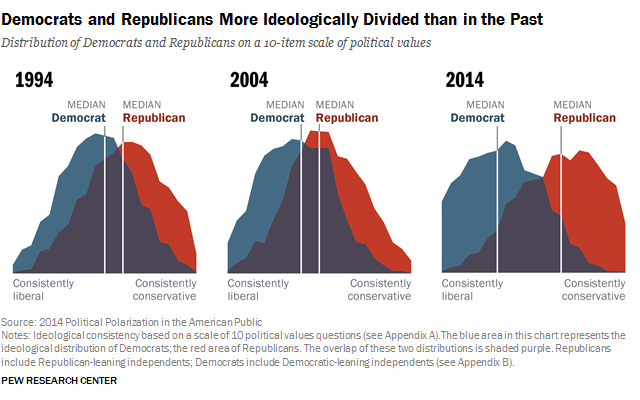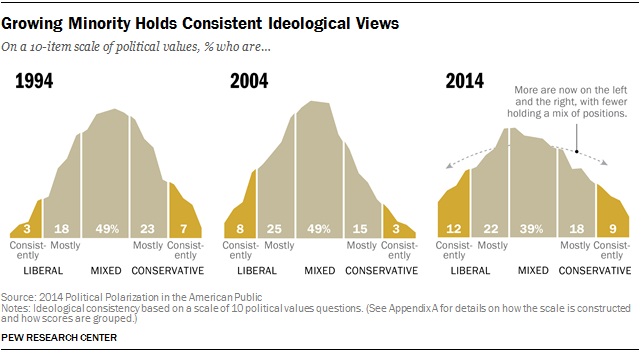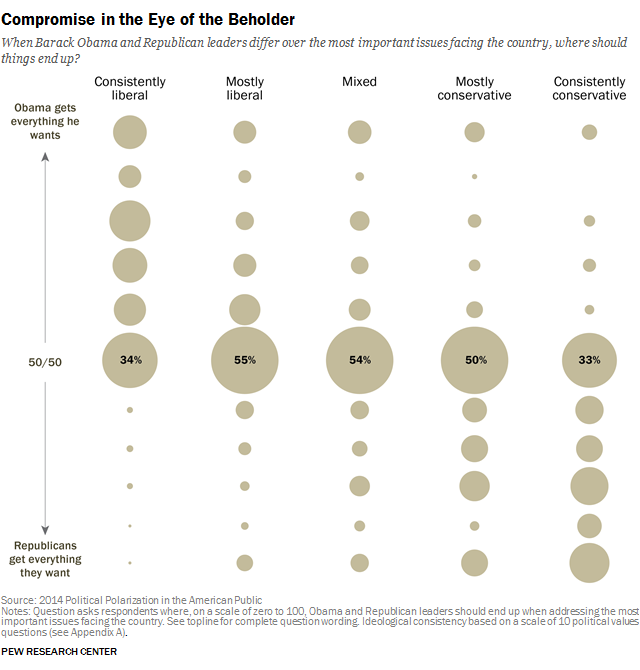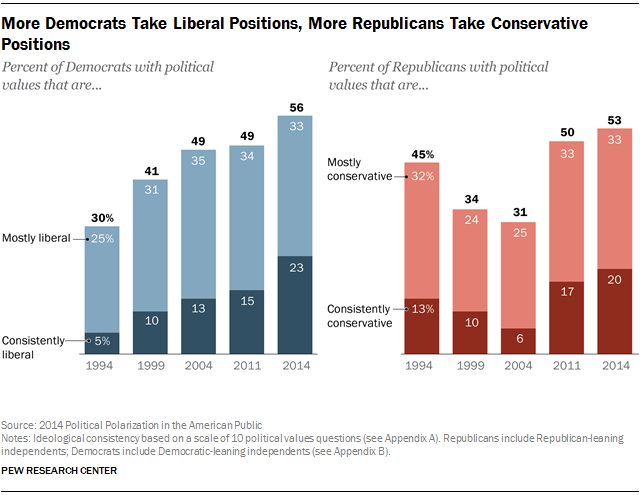Now See Thats Consistency Much Better But Done Now Again
Republicans and Democrats are more divided along ideological lines – and partisan contempt is deeper and more all-encompassing – than at whatsoever bespeak in the concluding two decades. These trends manifest themselves in myriad ways, both in politics and in everyday life. And a new survey of ten,000 adults nationwide finds that these divisions are greatest amongst those who are the most engaged and active in the political process.

The overall share of Americans who express consistently conservative or consistently liberal opinions has doubled over the past two decades from x% to 21%. And ideological thinking is at present much more than closely aligned with partisanship than in the past. As a result, ideological overlap between the two parties has macerated: Today, 92% of Republicans are to the right of the median Democrat, and 94% of Democrats are to the left of the median Republican.
Today 92% of Republicans are to the right of the median Democrat, and 94% of Democrats are to the left of the median Republican
Partisan antagonism has increased substantially over the aforementioned period. In each party, the share with a highly negative view of the opposing party has more than doubled since 1994. Most of these intense partisans believe the opposing party'due south policies "are and then misguided that they threaten the nation's well-being."

"Ideological silos" are at present common on both the left and right. People with down-the-line ideological positions – especially conservatives – are more probable than others to say that most of their close friends share their political views. Liberals and conservatives disagree over where they want to live, the kind of people they want to live effectually and even whom they would welcome into their families.
And at a time of increasing gridlock on Capitol Hill, many on both the left and the right think the outcome of political negotiations betwixt Obama and Republican leaders should be that their side gets more than of what it wants.
These sentiments are not shared by all – or fifty-fifty most – Americans. The majority do non have uniformly conservative or liberal views. Near do not see either political party as a threat to the nation. And more believe their representatives in government should meet halfway to resolve contentious disputes rather than hold out for more than of what they desire.
Yet many of those in the middle remain on the edges of the political playing field, relatively distant and disengaged, while the nigh ideologically oriented and politically rancorous Americans brand their voices heard through greater participation in every stage of the political procedure.
Many of those in the center remain on the edges of the political playing field … while the most ideologically oriented and politically rancorous Americans make their voices heard
The rise of ideological uniformity has been much more than pronounced amidst those who are the most politically agile. Today, almost four-in-ten (38%) politically engaged Democrats are consistent liberals, up from just 8% in 1994. The modify among Republicans since then appears less dramatic – 33% express consistently conservative views, up from 23% in the midst of the 1994 "Republican Revolution." Merely a decade ago, simply 10% of politically engaged Republicans had across-the-board bourgeois attitudes.

On measure after measure – whether primary voting, writing messages to officials, volunteering for or donating to a entrada – the most politically polarized are more actively involved in politics, amplifying the voices that are the least willing to see the parties meet each other halfway.
These are amidst the findings of the largest report of U.S. political attitudes ever undertaken past the Pew Research Heart. Data are drawn from a national telephone survey of x,013 adults, conducted from January through March of this year, and an ongoing serial of follow-up surveys. This rich dataset, coupled with trends and insights from 2 decades of Pew Research Centre polling, reveals a complex film of partisan polarization and how it manifests itself in political behaviors, policy debates, election dynamics and everyday life.
What Polarization Looks Like

To chart the progression of ideological thinking, responses to x political values questions asked on multiple Pew Research surveys since 1994 have been combined to create a measure out of ideological consistency. Over the by 20 years, the number of Americans in the "tails" of this ideological distribution has doubled from 10% to 21%. Meanwhile, the heart has shrunk: 39% currently take a roughly equal number of liberal and bourgeois positions. That is downwardly from nigh one-half (49%) of the public in surveys conducted in 1994 and 2004.
And this shift represents both Democrats moving to the left and Republicans moving to the correct, with less and less overlap betwixt the parties. Today, 92% of Republicans are to the right of the median (centre) Democrat, compared with 64% twenty years ago. And 94% of Democrats are to the left of the median Republican, up from seventy% in 1994.

More than Negative Views of the Opposing Party
Beyond the ascension in ideological consistency, another major element in polarization has been the growing contempt that many Republicans and Democrats accept for the opposing party. To exist sure, disliking the other party is nothing new in politics. Simply today, these sentiments are broader and deeper than in the recent past.
In 1994, hardly a time of amicable partisan relations, a majority of Republicans had unfavorable impressions of the Democratic Political party, but merely 17% had very unfavorable opinions. Similarly, while near Democrats viewed the GOP unfavorably, just xvi% had very unfavorable views. Since then, highly negative views accept more than doubled: 43% of Republicans and 38% of Democrats now view the opposite party in strongly negative terms.

Amid all Democrats, 27% say GOP policies are a threat to the well-being of the state; amid all Republicans, more than a third (36%) think Democratic policies threaten the nation.
Even these numbers tell only function of the story. Those who have a very unfavorable impression of each party were asked: "Would you say the political party's policies are so misguided that they threaten the nation's well-being, or wouldn't you go that far?" Nearly who were asked the question said yes, they would go that far. Among all Democrats, 27% say the GOP is a threat to the well-beingness of the country. That effigy is even higher among Republicans, 36% of whom think Democratic policies threaten the nation.
Politics Gets Personal
Liberals and conservatives share a passion for politics. They are far more than likely than those with more than mixed ideological views to discuss politics on a weekly or daily basis. But for many, particularly on the correct, those conversations may non include much in the way of opposing opinions.

People on the right and left are more than likely to say it is of import to them to live in a identify where almost people share their political views
Well-nigh two-thirds (63%) of consistent conservatives and nigh half (49%) of consistent liberals say nearly of their close friends share their political views. Amidst those with mixed ideological values, just 25% say the same. People on the correct and left also are more likely to say it is important to them to alive in a place where most people share their political views, though again, that desire is more widespread on the correct (fifty%) than on the left (35%).
And while few Americans overall become so far as to phonation disappointment with the prospect of a family fellow member marrying a Democrat (8%) or a Republican (9%), that sentiment is not uncommon on the left or the right. Three-out-of-ten (30%) consistent conservatives say they would be unhappy if an immediate family member married a Democrat and about a quarter (23%) of beyond-the-lath liberals say the same nigh the prospect of a Republican in-police force.
To be sure, at that place are areas of consensus. Most Americans, regardless of their ideological preferences, value communities in which they would live close to extended family and high-quality schools. But far more liberals than conservatives think it is important that a community have racial and ethnic diversity (76% vs. 20%). At the same fourth dimension, conservatives are more likely than liberals to adhere importance to living in a place where many people share their religious faith (57% vs. 17% of liberals).

And the differences between right and left get beyond disagreements over politics, friends and neighbors. If they could cull anywhere to alive, three-quarters of consequent conservatives prefer a community where "the houses are larger and further apart, but schools, stores, and restaurants are several miles away." The preferences of consistent liberals are near the exact inverse, with 77% saying they'd chose to live where "the houses are smaller and closer to each other, but schools, stores, and restaurants are within walking distance."
Polarization'due south Consequences
When they look at a political arrangement in which petty seems to get washed, nigh Americans in the center of the electorate remember that Obama and Republican leaders should only meet each other halfway in addressing the issues facing the nation.

Consistent liberals and conservatives define ideal political compromise every bit one in which their side gets more of what it wants
Nonetheless an equitable bargain is in the eye of the beholder, as both liberals and conservatives ascertain the optimal political outcome as one in which their side gets more of what it wants. A majority of consistent conservatives (57%) say the ideal agreement between President Obama and congressional Republicans is one in which GOP leaders concur out for more than of their goals. Consistent liberals take the opposite view: Their preferred terms (favored past 62%) end up closer to Obama's position than the GOP's.
Polarization in Cherry and Blue
The signs of political polarization are axiomatic on both ends of the political spectrum, though the trajectory, nature and extent differ from left to right.
With Barack Obama in the White House, partisan contempt is more pronounced among Republicans, peculiarly consistently conservative Republicans. Overall, more Republicans than Democrats come across the opposing party's policies as a threat and the differences are even greater when ideology is taken into business relationship. Fully 66% of consistently conservative Republicans retrieve the Democrats' policies threaten the nation'southward well-being. Past comparison, half (fifty%) of consistently liberal Democrats say Republican policies jeopardize the nation's well-being. Conservatives also exhibit more than partisan behavior in their personal lives; they are the virtually likely to accept friends and prefer communities of like-minded people.
However, there is every bit much ideological uniformity on the left as the right. The share of Democrats holding consistently liberal views has grown steadily over the past twenty years, quadrupling from 5% in 1994 to 23% today. Social issues like homosexuality and immigration that one time collection deep divides inside the Democratic Party are now areas of relative consensus. And Democrats take get more uniformly critical of business organisation and more supportive of government.

Changes in ideological consistency on the right have followed a different course. In 1994, during the "Republican Revolution," xiii% of Republicans were consequent conservatives. That effigy fell to 6% a decade later on during George W. Bush-league'southward presidency, before rebounding to 20% today. This increment has come despite more than moderate views amidst Republicans on problems like homosexuality and immigration, equally GOP thinking on bug related to government and the economic system has veered sharply to the right.
About the Study
This is the first study of a multi-office series based on a national survey of x,013 adults nationwide, conducted January 23-March xvi, 2014 by the Pew Research Center. The survey, funded in office through grants from the William and Flora Hewlett Foundation, the John D. and Catherine T. MacArthur Foundation and supported by the generosity of Don C. and Jeane M. Bertsch, is aimed at understanding the nature and scope of political polarization in the American public, and how information technology interrelates with government, society and people's personal lives.
The second report, coming in a few weeks, is the new Pew Research Center Political Typology. The typology – the 6th such written report since 1987 – looks beyond Cherry-red vs. Blueish divisions to gain a clearer understanding of the dynamic nature of the "heart" of the American electorate, and the internal divides on both the left and the right.
Later on, the projection volition explore the various factors that contribute to political polarization, or stem from information technology. A September report will examine how political polarization is linked to people'southward data environments: Their news sources, social media habits and interpersonal communication networks. Other reports will look at how political polarization relates to where people alive, to their political environments, to how they view themselves and others around them, to their socioeconomic circumstances, to generational changes and to broader sociological and psychological personality traits.
The electric current report is divided into five parts: The first two focus on measuring the nature and scope of political polarization, emphasizing the divergence between growing ideological consistency and rise partisan antipathy. The third looks closely at how polarization manifests itself in people'south personal lives. The 4th looks at the human relationship between polarization and applied policymaking, and the fifth digs deeper into how political participation both amplifies and reflects polarization.
About the Data
The data in this report are based on two independent survey administrations with the same randomly selected, nationally representative grouping of respondents. The showtime is the centre's largest survey on domestic politics to date: the 2014 Political Polarization and Typology Survey, a national telephone survey of x,013 adults, on landlines and cell phones, from Jan through March of this year. The second involved impaneling a subset of these respondents into the newly created American Trends Console and following up with them via a survey conducted by web and telephone. The ii surveys are described separately, in further item, in the About the Surveys department of the report.
Source: https://www.pewresearch.org/politics/2014/06/12/political-polarization-in-the-american-public/
0 Response to "Now See Thats Consistency Much Better But Done Now Again"
Post a Comment